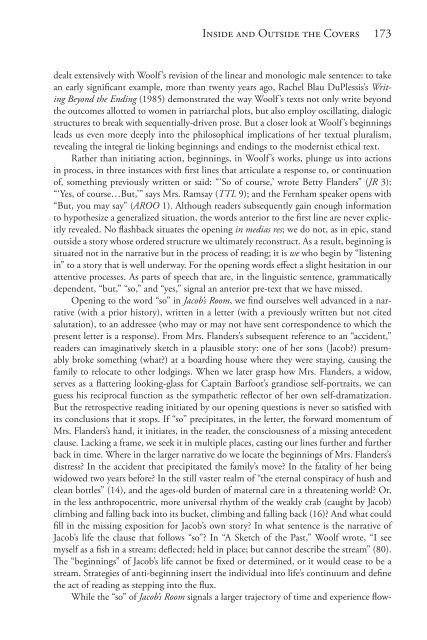Woolfian Boundaries - Clemson University
Woolfian Boundaries - Clemson University
Woolfian Boundaries - Clemson University
Create successful ePaper yourself
Turn your PDF publications into a flip-book with our unique Google optimized e-Paper software.
Inside and Outside the Covers<br />
173<br />
dealt extensively with Woolf’s revision of the linear and monologic male sentence: to take<br />
an early signifi cant example, more than twenty years ago, Rachel Blau DuPlessis’s Writing<br />
Beyond the Ending (1985) demonstrated the way Woolf’s texts not only write beyond<br />
the outcomes allotted to women in patriarchal plots, but also employ oscillating, dialogic<br />
structures to break with sequentially-driven prose. But a closer look at Woolf’s beginnings<br />
leads us even more deeply into the philosophical implications of her textual pluralism,<br />
revealing the integral tie linking beginnings and endings to the modernist ethical text.<br />
Rather than initiating action, beginnings, in Woolf’s works, plunge us into actions<br />
in process, in three instances with fi rst lines that articulate a response to, or continuation<br />
of, something previously written or said: “‘So of course,’ wrote Betty Flanders” (JR 3);<br />
“‘Yes, of course…But,’” says Mrs. Ramsay (TTL 9); and the Fernham speaker opens with<br />
“But, you may say” (AROO 1). Although readers subsequently gain enough information<br />
to hypothesize a generalized situation, the words anterior to the fi rst line are never explicitly<br />
revealed. No fl ashback situates the opening in medias res; we do not, as in epic, stand<br />
outside a story whose ordered structure we ultimately reconstruct. As a result, beginning is<br />
situated not in the narrative but in the process of reading; it is we who begin by “listening<br />
in” to a story that is well underway. For the opening words eff ect a slight hesitation in our<br />
attentive processes. As parts of speech that are, in the linguistic sentence, grammatically<br />
dependent, “but,” “so,” and “yes,” signal an anterior pre-text that we have missed.<br />
Opening to the word “so” in Jacob’s Room, we fi nd ourselves well advanced in a narrative<br />
(with a prior history), written in a letter (with a previously written but not cited<br />
salutation), to an addressee (who may or may not have sent correspondence to which the<br />
present letter is a response). From Mrs. Flanders’s subsequent reference to an “accident,”<br />
readers can imaginatively sketch in a plausible story: one of her sons (Jacob?) presumably<br />
broke something (what?) at a boarding house where they were staying, causing the<br />
family to relocate to other lodgings. When we later grasp how Mrs. Flanders, a widow,<br />
serves as a fl attering looking-glass for Captain Barfoot’s grandiose self-portraits, we can<br />
guess his reciprocal function as the sympathetic refl ector of her own self-dramatization.<br />
But the retrospective reading initiated by our opening questions is never so satisfi ed with<br />
its conclusions that it stops. If “so” precipitates, in the letter, the forward momentum of<br />
Mrs. Flanders’s hand, it initiates, in the reader, the consciousness of a missing antecedent<br />
clause. Lacking a frame, we seek it in multiple places, casting our lines further and further<br />
back in time. Where in the larger narrative do we locate the beginnings of Mrs. Flanders’s<br />
distress? In the accident that precipitated the family’s move? In the fatality of her being<br />
widowed two years before? In the still vaster realm of “the eternal conspiracy of hush and<br />
clean bottles” (14), and the ages-old burden of maternal care in a threatening world? Or,<br />
in the less anthropocentric, more universal rhythm of the weakly crab (caught by Jacob)<br />
climbing and falling back into its bucket, climbing and falling back (16)? And what could<br />
fi ll in the missing exposition for Jacob’s own story? In what sentence is the narrative of<br />
Jacob’s life the clause that follows “so”? In “A Sketch of the Past,” Woolf wrote, “I see<br />
myself as a fi sh in a stream; defl ected; held in place; but cannot describe the stream” (80).<br />
Th e “beginnings” of Jacob’s life cannot be fi xed or determined, or it would cease to be a<br />
stream. Strategies of anti-beginning insert the individual into life’s continuum and defi ne<br />
the act of reading as stepping into the fl ux.<br />
While the “so” of Jacob’s Room signals a larger trajectory of time and experience fl ow-
















